I first discovered the value of craniosacral th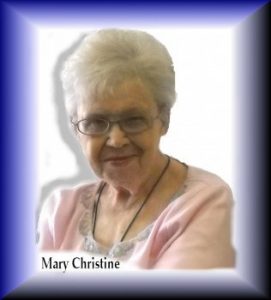 erapy for vertigo back in 1994 when my Mom, then sixty-five, began having severe dizzy spells. The spinning sensations were so bad she could barely take a step without stumbling to the side and grabbing on to something to keep herself from falling. The attacks occurred three to four times a week and she had to lie down and wait 6 to 8 hours for the dizziness to pass. Along with the vertigo, she experienced pressure and ringing in the ears, hearing loss that worsened during the attacks, pain in the left cheek, excess saliva, and a bitter taste in her mouth. Her primary physician diagnosed an inner ear problem and prescribed meclizine.
erapy for vertigo back in 1994 when my Mom, then sixty-five, began having severe dizzy spells. The spinning sensations were so bad she could barely take a step without stumbling to the side and grabbing on to something to keep herself from falling. The attacks occurred three to four times a week and she had to lie down and wait 6 to 8 hours for the dizziness to pass. Along with the vertigo, she experienced pressure and ringing in the ears, hearing loss that worsened during the attacks, pain in the left cheek, excess saliva, and a bitter taste in her mouth. Her primary physician diagnosed an inner ear problem and prescribed meclizine.
Unfortunately, the medication did little to alleviate the symptoms and the attacks continued for six months. I actually had to carry her out of the office when she had an attack during a doctor’s visit. The patients were aghast that the doctor would let her leave in that condition, but there was really nothing he could do. Still, it was a disconcerting feeling to see the doctor simply turn his back on her as I carried her out.
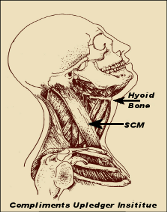 I had been practicing therapeutic body work for almost fifteen years at that time, but only recently had begun to study craniosacral therapy. Slight movement in the joints of the skull bones was said to allow for expansion and contraction of the membranes that surround the brain and spinal cord in response to rhythmic fluid pressure changes within the membranes. Each of the cranial bones was said to move in a characteristic pattern. The temporal bones on either the side of the head to which our ears are attached were said to move forward and backward simultaneously in sync with the 6 to 12 cycles per minute of the craniosacral rhythm. Because the balance organs reside deep in the temporal bones any abnormal movement of these bones can cause vertigo.
I had been practicing therapeutic body work for almost fifteen years at that time, but only recently had begun to study craniosacral therapy. Slight movement in the joints of the skull bones was said to allow for expansion and contraction of the membranes that surround the brain and spinal cord in response to rhythmic fluid pressure changes within the membranes. Each of the cranial bones was said to move in a characteristic pattern. The temporal bones on either the side of the head to which our ears are attached were said to move forward and backward simultaneously in sync with the 6 to 12 cycles per minute of the craniosacral rhythm. Because the balance organs reside deep in the temporal bones any abnormal movement of these bones can cause vertigo.
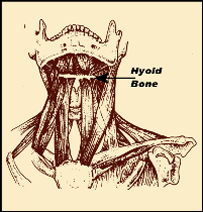 After several general sessions without result, I decided to zoom in on the temporal bones. I noticed that the movement of the bones was sluggish and erratic with no regular pattern of movement, almost as if they were stuck in cold molasses. The muscles on the side of her neck called the sternocleidomastoids or SCM muscles were so tight and twisted that when I lifted her head the tight muscles yanked her head this way and that with great force as if struggling to get free of some powerful grip. I noticed that the muscles under her tongue were so tight that there was a bulge under her chin that made her look like a bullfrog. The bulge was hard as rock. It appeared that the muscles attached to the floating hyoid bone just below the tongue were tightly contracting.
After several general sessions without result, I decided to zoom in on the temporal bones. I noticed that the movement of the bones was sluggish and erratic with no regular pattern of movement, almost as if they were stuck in cold molasses. The muscles on the side of her neck called the sternocleidomastoids or SCM muscles were so tight and twisted that when I lifted her head the tight muscles yanked her head this way and that with great force as if struggling to get free of some powerful grip. I noticed that the muscles under her tongue were so tight that there was a bulge under her chin that made her look like a bullfrog. The bulge was hard as rock. It appeared that the muscles attached to the floating hyoid bone just below the tongue were tightly contracting.
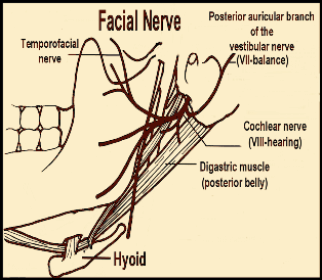 After much study and contemplation, I came to the conclusion that Mom’s symptoms were caused by a compression of a small passageway between the temporal bones and base of the skull called the jugular foramen. Several cranial nerves pass through this opening as well as the jugular vein. Restriction of these nerves, the vagus, glossopharyngeal and spinal accessory nerves, along with the facial nerve which exits through another nearby passage could account for all the symptoms. Restriction of the vagus nerve could cause nausea; the glossopharyngeal difficulty swallowing; the facial nerve pain in the cheek and excess salivation etc. Restriction of the spinal accessory nerve can tighten the SCM muscles which in turn can put tension on the temporal bones further restricting the nerve in a vicious cycle. I was beginning to understand, but what to do about it?
After much study and contemplation, I came to the conclusion that Mom’s symptoms were caused by a compression of a small passageway between the temporal bones and base of the skull called the jugular foramen. Several cranial nerves pass through this opening as well as the jugular vein. Restriction of these nerves, the vagus, glossopharyngeal and spinal accessory nerves, along with the facial nerve which exits through another nearby passage could account for all the symptoms. Restriction of the vagus nerve could cause nausea; the glossopharyngeal difficulty swallowing; the facial nerve pain in the cheek and excess salivation etc. Restriction of the spinal accessory nerve can tighten the SCM muscles which in turn can put tension on the temporal bones further restricting the nerve in a vicious cycle. I was beginning to understand, but what to do about it?
The hyoid is the floating bone under your chin that rises and falls when you swallow or sing. The digastric muscle attaches to the temporal bone and slings around the hyoid bone which is the only bone in the body not connected to any other bones. If I performed a hyoid release it might relieve the digastric tension on the temporal bone releasing the compression on the bones that seemed to be restricting the nerves. I gently held the hyoid horizontally with my thumb and middle finger on either side of the hard bulge and cupped the back of her skull with my other hand—and waited. And waited and waited. Nothing happened.
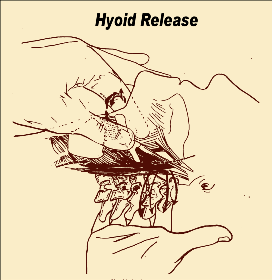 Then I very gently increased the pressure by degrees until suddenly the bulge softened. At the same time I felt a release under my other hand which was holding Mom’s head across the opening in the skull bones where the nerves pass. It felt something like the snap on a jacket opening. Immediately the skin and muscles under my fingers softened, and the neck muscles relaxed. The temporal bones started to move again in sync, and instantaneously all of the symptoms (with the exception of the ringing in the ears) disappeared! Her hearing returned to normal, although she still had some baseline hearing loss that she had had before the vertigo. The pain in the ear canal and left cheek disappeared as well as the bitter taste and excess saliva in her mouth. When Mom stood up the vertigo was gone and never returned.
Then I very gently increased the pressure by degrees until suddenly the bulge softened. At the same time I felt a release under my other hand which was holding Mom’s head across the opening in the skull bones where the nerves pass. It felt something like the snap on a jacket opening. Immediately the skin and muscles under my fingers softened, and the neck muscles relaxed. The temporal bones started to move again in sync, and instantaneously all of the symptoms (with the exception of the ringing in the ears) disappeared! Her hearing returned to normal, although she still had some baseline hearing loss that she had had before the vertigo. The pain in the ear canal and left cheek disappeared as well as the bitter taste and excess saliva in her mouth. When Mom stood up the vertigo was gone and never returned.